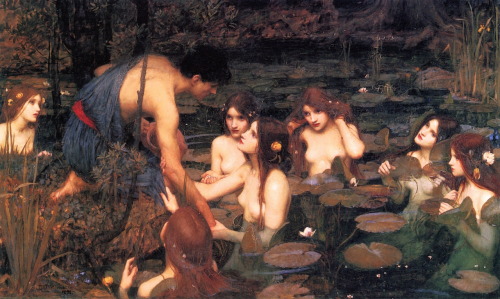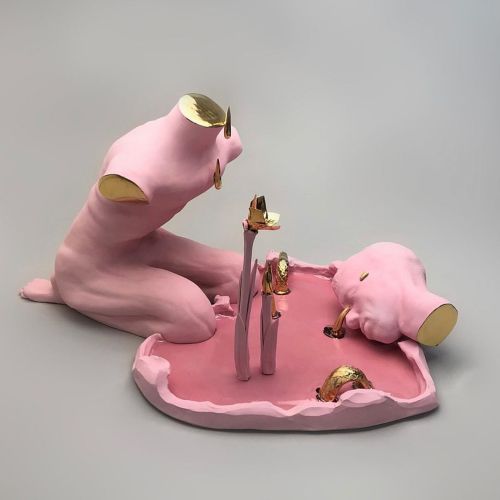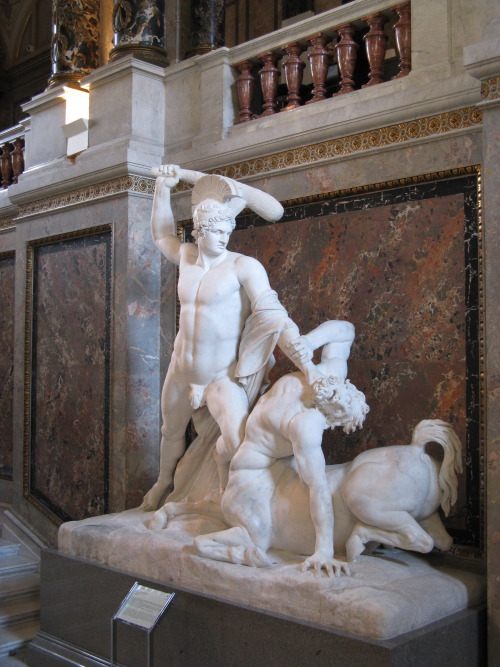#metamorphoses
Hylas and the Nymphs (1896), by J.W. Waterhouse
Hylas is a character from Greek and Roman mythology as recorded in the Metamorphoses by the poet Ovidius. Whereas in 1893, Waterhouse painted only one nymph approaching the sleeping Hylas, we see here a group of seven water nymphs (naiads) surprising Hylas when he is filling his jar with water from the pond. The nymphs all have very similar faces to stress that they are no ordinary human beings. Their erotic desire makes them lure Hylas into the pond where he will drown. Waterhouse had a fascination for strong, but fatal women associated with water. One can only guess what this is based on.
In 2018, this painting attracted a lot of media attention when the Manchester Art Gallery moved it out of public display as a move “against the objectification and exploitation of women”. After a storm of protests against this form of censorship, the Manchester City Council ordered that the painting should be moved back in its original position.
Post link
Apollo and Daphne (1908), by J.W. Waterhouse
Yet another example where a nymph transforms into a tree (see also Phyllis and Demophoön, 1905). Here Daphne is fleeing from Apollo’s advances because she decided to remain a virgin. To help her, she is turned into a laurel tree by her father, the river-god Peneus who is represented by the river in the background. Apollo continued to admire the laurel tree and used his eternal youth to prevent the leaves from withering.
The work is clearly inspired by the marble statue of Bernini from Galleria Borghese in Rome. Waterhouse never managed to sell this painting and that is probably also because the art critics reviewed it in a very negative way. They criticized in particular the feeble representation of Apollo.
Post link
(The) Danaïdes (1904/1906), by J.W. Waterhouse
Women and water somehow intrigued Waterhouse so it is no surprise that he painted the Danaïdes. These 50 daughters of King Danaus were forced to marry the 50 sons of his rival King Aegyptus with the task to kill them in their wedding night. After the killings, the women were sentenced to death and in the underworld they were condemned to fill a large jar with a big hole in it. Only one daughter refused to assassinate her husband because she truly loved him and this couple started the dynasty of the new rulers of Argos.
The first shown painting is regarded as a study of the second one that was completed two years later. Being only discovered in 1989, it is nevertheless a painting in its full right. The later version was sold to the magnate James Murray and ended up in the Aberdeen Art Gallery in 1927.
Post link
“Ovid’s uncertainty over what kind of gods are in charge of his world in the Metamorphoses shows both that gods are unworthy of respect, and that it is dangerous not to respect them: the poem problematizes both belief and non-belief.”
James J. O'Hara, Inconsistency in Roman Epic
CLOSING TODAY: @100alexanderson’s solo exhibition, , at GAVLAK Palm Beach! #LastChance
:
Installation View, GAVLAK Palm Beach, 2021
© Photography: @mlopezfotos1
___
#alexanderson #gazingpool #narcissus #millennial #ceramic #pink #ovid #metamorphoses #reflection #ceramicart #ceramicsculpture #ceramicartist #contemporarysculpture #identitycrisis #identitypolitics #contemporaryceramics (at Gavlak Gallery)
https://www.instagram.com/p/CKOq1ywFOi7/?igshid=wpd5ng8n2uxp
Post link
✨#TheGazingPool is on view now through January 19th at GAVLAK Palm Beach.
Using the ancient myth of Narcissus, Alex Anderson’s (@100alexanderson) work in investigates the cultural phenomenon of millennial self-absorption. , a figurative sculpture that anchors the entire exhibition, depicts this myth with a kneeling figure adjacent to its own detached head. Further drawing upon this myth, the head of Narcissus is crying, dripping exaggerated golden tears into the pool in which he will drown.
:
Installation View, GAVLAK Palm Beach, 2021
___
#alexanderson #gazingpool #narcissus #millennial #ceramic #pink #ovid #metamorphoses #reflection #ceramicart #ceramicsculpture #ceramicartist #contemporarysculpture #identitycrisis #identitypolitics #contemporaryceramics (at The Royal Poinciana Plaza)
https://www.instagram.com/p/CJuRu9MF4AN/?igshid=1b4o2efd8whhe
Post link
#TheGazingPool, @100alexanderson’s third solo exhibition with the gallery, opens Saturday, 1/6, at GAVLAK Palm Beach!
, , ? : , ! : . , , !
— , , : -
The show consists of thirteen new ceramic works Anderson created during his Fall 2020 residency at @archie_bray Foundation for the Ceramic Arts in Helena, MT.
Alex Anderson
, 2020
Earthenware, glaze, and gold luster
20 x 38 x 22 in (50.8 x 96.5 x 55.9 cm)
___
#alexanderson #gazingpool #narcissus #ceramicart #contemporarysculpture #ceramicsculpture #ovid #metamorphoses #palmbeachart (at Gavlak Gallery)
https://www.instagram.com/p/CJjZb_slXnr/?igshid=1xqlmsm6jzigk
Post link
METAMORPHOSES
A collection of colouring pages by Mayticks, set alongside a selection of ancient (2280 BCE - 8 CE) verses of poetry on the themes of love and change.
25 spreads featuring line art pages alongside poetry on high-quality 140gsm paper in a saddle-stitched A4 book.
Link
Theseus and the Centaur (1804-19)
Antonio Canova (b. 1757, Possagno, d. 1822, Venezia)
Theseus’s best friend was Pirithous, prince of the Lapiths. Pirithous had heard stories of Theseus’s courage and strength in battle but wanted proof, so he rustled Theseus’s herd of cattle and drove it from Marathon, and Theseus set out in pursuit. Pirithous took up his arms and the pair met to do battle, but were so impressed with each other they took an oath of friendship and joined the hunt for the Calydonian Boar. In Iliad I, Nestor numbers Pirithous and Theseus “of heroic fame” among an earlier generation of heroes of his youth, “the strongest men that Earth has bred, the strongest men against the strongest enemies, a savage mountain-dwelling tribe whom they utterly destroyed." Later, Pirithous was preparing to marry Hippodamia. The centaurs were guests at the wedding feast, but got drunk and tried to abduct the women, including Hippodamia. The Lapiths won the ensuing battle.
In Ovid’s Metamorphoses Theseus fights against and kills Eurytus, the "fiercest of all the fierce centaurs” at the wedding of Pirithous and Hippodamia. Hovever Theseus fights several centaurs in his life, and Eurytius is not beaten with a club in Ovid’s tale. Thus Canova could have found inspiration in a different source.
Marble, height 340 cm
Kunsthistorisches Museum, Vienna
Post link

feeling sorta self conscious right now but on the other hand I wanted to post some art on my dream dress. night carnival looks so cute. I just saw it on lace market too
“Eurydice, dying now a second time, uttered no complaint against her husband. What was there to complain of, but that she had been loved?”—
Ovid,Metamorphoses, Book X
Iamque iterum moriens non est de coniuge quicquam questo suo: quid enim nisi se quereretur amatam?
per me, quod eritque fuitque
estque, patet
Tanaquil Le Clercq and Nicholas Magallanes, posing on a roof in Venice, wearing their costumes for “Metamorphoses,” which was produced by the New York City Ballet at the Teatro La Fenice, in September 1953.Music by Paul Hindemith (Metamorphoses on Themes of Weber). Costumes by Barbara Karinska. Choreography by George Balanchine. First given at the New York City Center on November 25, 1952. Photo: Serge Lido.
Post link
In Athens, there reigned a great fighter. His true name is not remembered, for he won so many Olympic boxing matches that he came to be known as Bruiser, the fiercest boxer in the world. He was tall and broad-backed. An average-sized man was dwarfed standing next to him. Men would travel from across the land to fight Bruiser, but one by one he defeated them all with ease.
He had never bled. In all of his years of fighting and living, the magnificent fighter had never been injured to the point of bleeding. In every battle he had ever fought in, not one arrow or sword ever grazed him, though he killed many with arrows and swords of his own. He was indestructible in the eyes of mortals, he was honorable in the eyes of the gods. The gods respected his power and dared not test it. He respected the gods in return, and praised Jupiter with every one of his victories in the Olympic Games. Jupiter was pleased by this and held Bruiser in his favor.
However, there was one god who remained unimpressed by Bruiser’s fighting abilities. Mars, the god of war, regarded himself as the greatest fighter of all, and thought Bruiser to be inferior to him. One day, Mars caught sight of Dásos, wife to Bruiser, and was overcome with lust. Mars took on a human form and descended to the Earth. Mars tried many times to woo her when she was alone in the marketplace, but Dásos remained unmoved and faithful to Bruiser. Offended, Mars stormed away to Dásos’ home, awaiting for her to return. When Dásos returned, Mars ambushed and raped her in her in her home.
Bruiser, who had been hunting that day, returned home and found Mars and Alexandra in bed together. Outrage filled him like it never had before, and he roared loudly at the intruder, “Do you know what you have done!? Do you know who I am!?” Mars lay calmly in Bruiser’s bed, and said “Yes, you are Bruiser, and this is your wife, and I have raped her, but you cannot do anything to stop me. I am Mars, the god of war, and I am the greatest fighter there is. You are not the only one to have never bled in your life.”
At this, Bruiser lost all composure and leaped wildly at Mars. He struck him hard across the face and broke his nose, and Mars bled profusely on the ground. “Now you have bled, and I am the better fighter. Leave now before I harm you further.” Mars was in shock. He had never been struck in a fight ever before. Furious, he revealed himself in his divine form and killed Bruiser where he had been standing over Mars’ human form. Bruiser’s body fell, bleeding in the pool of Mars’ blood.
Mars, still deeply upset and angry over his defeat, turned then to Dásos, who was weeping after seeing her husband killed. He killed her too, and left the home in anger.
Meanwhile, Bruiser’s body lay in his own blood and the blood of Mars. In the blood of Mars there was immortality, and the immortality mixed with Bruiser’s mortal blood, and Bruiser was wakened from death. However, the mix of human and inhuman blood turned Bruiser into a wild beast. When Bruiser was fully revived, he was no longer human, but a great bear. He woke in a haze and saw the body of Dásos, and he roared loudly in sorrow.
Jupiter heard him and felt pity for him, so he decided to revive Dásos. However, he knew that if he simply revived her, she would not recognize Bruiser and would be terrified of him. Therefore, Jupiter turned Dásos into a forest, a thousand trees for Bruiser to make his home. This way, Bruiser could always be with her, and protect her forever. Bruiser became the sacred guardian of Dásos. From that day onward, even Mars’ bravest soldiers trembled at the idea of intruding into the forest, for they knew that Bruiser reigned there, and that he was strong enough to make even Mars bleed.

now strike swift set sail for naxos

















